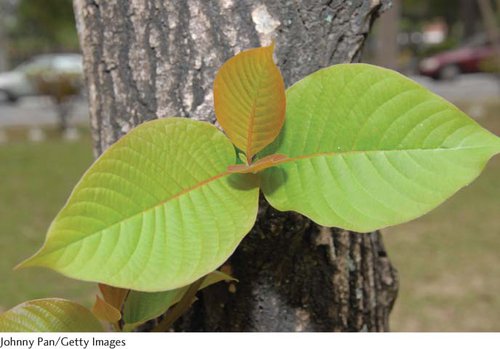Topoisomerase, Replication, and Cancer
9
DNA Replication and Recombination

In 1966, Monroe Wall and Mansukh Wani found a potential cure for cancer in the bark of the happy tree (Camptotheca acuminata), a rare plant native to China. Wall and Wani were in the process of screening a large number of natural substances for anticancer activity, hoping to find chemicals that might prove effective in cancer treatment. They discovered that an extract from the happy tree was effective in treating leukemia in mice. Through chemical analysis, they were able to isolate the active compound, which was dubbed camptothecin.
In the 1970s, physicians administered camptothecin to patients with incurable cancers. Although the drug showed some anticancer activity, it had toxic side effects. Eventually, chemists synthesized several analogs of camptothecin that were less toxic and more effective in cancer treatment. Two of those analogs, topotecan and irinotecan, are used today for the treatment of ovarian cancer, small-
For many years, the mechanism by which camptothecin compounds inhibited cancer was unknown. In 1985, almost 20 years after its discovery, scientists at Johns Hopkins University and Smith Kline and French Laboratories (now GlaxoSmithKline) showed that camptothecin worked by inhibiting an important component of the DNA-
Cancer chemotherapy is a delicate task because the target cells are the patient’s own and the drugs must kill the cancer cells without killing the patient. One of the hallmarks of cancer is proliferation: the division of cancer cells is unregulated, and many cancer cells divide at a rapid rate, giving rise to a tumor with the ability to grow and spread. As we learned in Chapter 2, before a cell can divide, it must successfully replicate its DNA so that each daughter cell receives an exact copy of the genetic material. Checkpoints in the cell cycle ensure that cell division does not proceed if DNA replication is inhibited or faulty, and many cancer treatments focus on interfering with the process of DNA replication.
DNA replication is a complex process that requires a large number of components, the action of which must be intricately coordinated to ensure that DNA is accurately copied. An essential component of replication is topoisomerase. As the DNA unwinds in the replication process, strain builds up ahead of the separation, and the two strands writhe around each other, much as a rope knots up as you pull apart two of its stands. This writhing of the DNA is called supercoiling (see Chapter 8). If the supercoils are not removed, they eventually stop strand separation, and the process of replication comes to a halt. Topoisomerase enzymes remove the supercoils by clamping tightly to the DNA and breaking one or both of its strands. The strands then revolve around each other, removing the supercoiling and strain. After the DNA has relaxed, the topoisomerase reseals the broken ends of the DNA strands.
234
Camptothecin works by interfering with topoisomerase I, an enzyme used in DNA replication in humans. The drug inserts itself into the gap created by the break in the DNA strand, blocking the topoisomerase from resealing the broken ends. Researchers originally assumed that camptothecin trapped the topoisomerase and blocked the action of other enzymes that were necessary to synthesize the DNA. However, recent research indicates that camptothecin poisons the topoisomerase so that it is unable to remove supercoils ahead of replication. Accumulating supercoils halt the replication machinery and prevent the proliferation of the cancer cells. But like many other anticancer drugs, camptothecin also inhibits the replication of normal, noncancerous cells, which is why chemotherapy often makes the patient sick.
This chapter focuses on DNA replication, the process by which a cell doubles its DNA before division. We begin with the basic mechanism of replication that emerged from the structure of DNA discovered by Watson and Crick. We then examine several different modes of replication, the requirements of replication, and the universal direction of DNA synthesis. We examine the enzymes and proteins that participate in this process and, finally, consider the molecular details of recombination, which is closely related to replication and is essential for the segregation of homologous chromosomes, the production of genetic variation, and DNA repair.